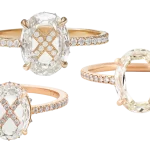With elongated diamonds getting lots of consumer love, this tapered cut is finding new audiences
The trend for finger-flattering diamond shapes has pushed the marquise cut back into the spotlight, particularly among consumers who want a lengthening effect.
“Elongated shapes have been in demand, and there is nothing as elongated as the marquise,” says Josh Arazi, vice president of jeweler Arazi Eternity in New York.
On the west coast, Sam Karmiel admits he has “paid new attention” to this cut as the popularity of oval and moval shapes has brought the more austere marquise back into fashion. “I am one of those people who will always try and convince a client to go with it,” says Karmiel, who owns Los Angeles-based jeweler IceRock Diamonds.
For rare- and antique-stone dealer Anup Jogani, owner of Jogani Gallery in Los Angeles, it’s the older and unmodified marquise-shaped brilliant cuts, with their “clean facet structure and crisp lines,” that are most desirable for his clientele.
He compares them to newer examples of marquise cuts that have emerged since the 1990s, which have a modified pavilion to achieve a sparkly “crushed-ice look” but that “don’t lend themselves to the same type of beauty,” he says.
The mighty moval
Dealers agree that the trend of elongated cushion and oval diamonds has influenced the market for marquises. A common preference is an adapted stone with the tapered edges of a marquise and the softened tips of an oval.
One of the best examples is the Movál by Rahaminov Diamonds — a trademarked hybrid shape that combines the best of both, according to Melanie Goldfiner Goldberg, the brand’s director of marketing and business development.
“The Rahaminov Diamonds Movál is designed with 54 facets, as opposed to a traditional marquise, which has 56, and a traditional oval, which has 58,” she explains. “We do this to avoid any bowties” — a darkening effect that can show up in the middle of an oval if light can’t enter the diamond properly. “The result [of the Movál cut] is significant finger coverage, the face of a high-carat oval, and higher brilliance than many other cuts of a similar style.”
‘Flattering and sexy’
The creative potential of today’s marquise, oval, elongated cushion, and adapted moval diamonds is inspiring designers. Zarig Jewelry founder Zarig Baghdadlian describes the marquise as an “incredibly flattering and sexy” shape, adding that she personally owns a marquise-cut, 1.50-carat, nude-color diamond for daily wear.
“I think marquise cuts are making a comeback,” says the New York-based designer. “Ovals were a very strong trend for the past five to six years, after which elongated ovals started having a moment, and eventually, marquises will be much more in demand, until we go back to the classic round brilliant shape. It’s always cyclical.”
Harakh Mehta, founder of jewelry house Harakh, agrees that marquises are booming. In fact, he notes, “due to the immense popularity, they are becoming difficult to source.” He has also seen a significant increase in “collectors requesting different shapes of marquise,” with some preferring skinnier stones over wider proportions. Highlights include the brand’s Cascade collection, which features rose-cut marquise diamonds. These “provide a great base to the design, from which other diamonds spring up to form the cascade effect,” he explains.
Selling the look
Despite its success, the marquise has some marketing challenges to overcome. Arazi highlights the cut’s age-old reputation as a “grandmother’s shape,” which has given it a mixed reception among emerging generations in his customer base. It’s only the fashion-forward, “non-ordinary” clients who are willing to embrace the shape’s potential, he says, especially if it’s “cut well and set in modern, sophisticated designs.”
Jogani, who recently sold a 40-carat marquise diamond to a collector, believes the market for this cut is worth watching closely. “The trend is going to continue,” he predicts, “because you can do a lot with a marquise that’s quite interesting, especially with some of the new designers and bezel settings that really accentuate the shape.” As an example, he points to Dutch jeweler Leen Heyne, whose signature aesthetic lends itself to long, shapely diamonds.
Design potential aside, there’s one benefit that’s always going to sway budget-conscious customers: “It creates the illusion of a larger diamond,” says Karmiel — so if maximizing carat weight is the goal, he’s more than happy to guide clients in the direction of the marquise.
BRON: Rapaport 02-04-2024




